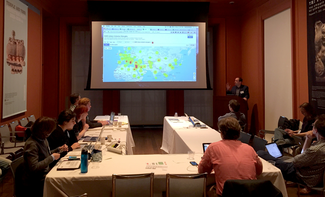Libraries
This article first appeared in ISAW Newsletter 17, Winter 2017.
David M. Ratzan
Head Librarian
 ISAW Library’s Gabriel Mckee demonstrates his recent work in mapping data about the library’s collection at the Digital Antiquity Research Workshop
We have had a very busy fall term in the ISAW Library, in no small part due to the addition to our team of Patrick Burns, Assistant Research Scholar, Digital and Special Projects, which, I am happy to report, has allowed us to move ahead on several of our digital projects and to increase our teaching role at ISAW.
ISAW Library’s Gabriel Mckee demonstrates his recent work in mapping data about the library’s collection at the Digital Antiquity Research Workshop
We have had a very busy fall term in the ISAW Library, in no small part due to the addition to our team of Patrick Burns, Assistant Research Scholar, Digital and Special Projects, which, I am happy to report, has allowed us to move ahead on several of our digital projects and to increase our teaching role at ISAW.
With respect to our digital agenda, we have made some truly excellent progress. For instance, we have done some interesting work on visualizing our collection, so that patrons may search for new titles by geography (you may now do this yourself by going to the ISAW Library website). We also successfully petitioned the Library of Congress to accept Pleiades IDs—unique linked data identifiers for historical places generated by Pleiades, an online digital gazetteer edited by ISAW’s Tom Elliott—in MARC records, the global standard for library digital metadata. In practice, this means that the otherwise inert MARC records can now be linked and interact with the growing web of online data. (See the article in Digital Programs.) This is an exciting development and I hope to have more to report on this soon.
One of the highlights of our term was the second Digital Antiquity Research Workshop, which the ISAW Library co-sponsored with Digital Programs (a full account of the program is available online on the ISAW Library Blog). Building on ISAW’s contribution to the Linked Ancient World Data Institute (LAWDI) meetings in 2012 and 2013, the workshop, now under the umbrella of Linked Ancient World Data, New York (LAWDNY), brought together faculty, students, and scholars for an informal all-day exchange of ideas on current digital work in ancient studies. This year we had thirty participants and nine presentations, with presenters coming from all over the Northeast and as far away as Ohio. Topics ranged from engaging undergraduates in digital projects at liberal arts colleges, to cultural heritage documentation, to text analysis and visualization in service of stylistics and genre studies. ISAW graduate student Christine Roughan spoke about her work modeling the Tower of the Winds before giving a tour of our current exhibition, Time and Cosmos, with Sebastian Heath and Alexander Jones, which focused on the role such models play in exhibition and teaching contexts.
On the teaching front, library staff collaborated with Digital Programs on a new course, “Introduction to Digital Humanities for the Ancient World” (see the contribution in this Newsletter). Stemming from this class have been several encouraging developments, not least the informal Python workshop Patrick organized this term for graduate students and Visiting Research Scholars, which will continue this term.
If you would like ongoing updates on our activities between Newsletters—from monthly notices of new acquisitions to news about our digital projects and the staff’s scholarly work—please follow the ISAW Library Blog or the ISAW Library Facebook or Twitter accounts (@ISAWlib).